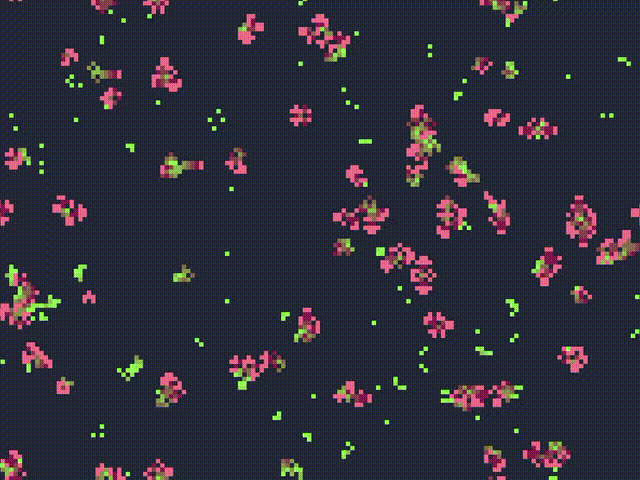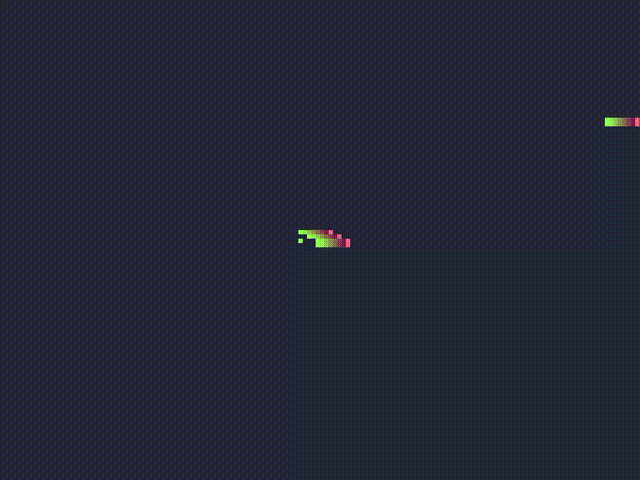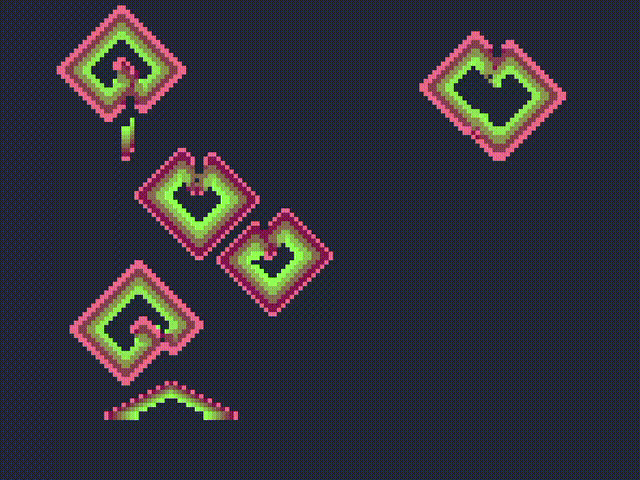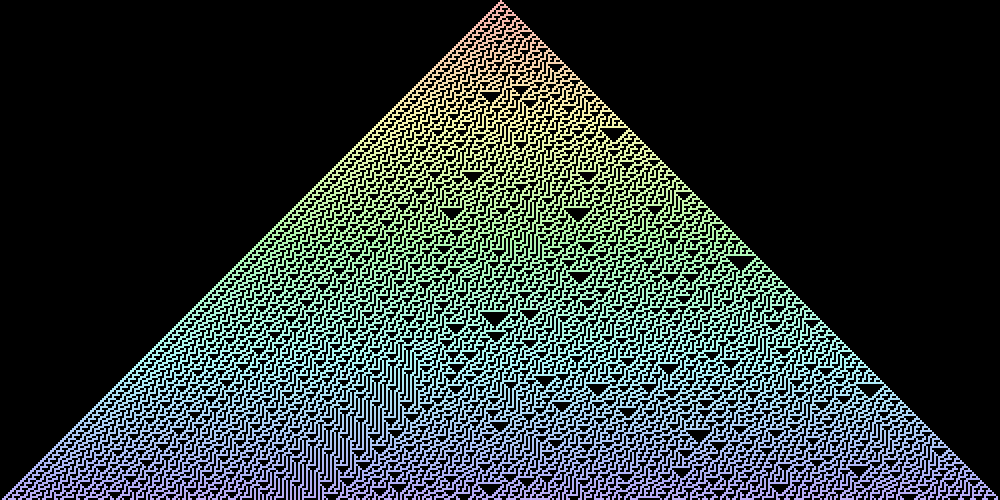Cellular Automata
9 minutes read •
Table of Contents
- What are Cellular Automata and why are they interesting?
- Some Popular Cellular Automata
- Conclusion
- References
What are Cellular Automata and why are they interesting?
Automata is the plural form of automaton. In automata theory, an automaton can be described as a discrete model of computation that has a number of states and has rules for transitioning between those states. Thus, Cellular Automata(CA) are a class of automata that operate over a grid of cells, where each cell can have a finite number of states and transitions between those states based on the state of its neighboring cells. Cellular Automata are discrete, meaning that the cells transition between different states in discrete time-steps. The overall state of the CA at any time-step is called a generation. The history of Cellular Automata goes back to the 40s and their application is mostly in the modeling of various physical, biological or even sociological phenomena.
In the last article, I discussed about the idea of emergence and how even agents with limited capabilities, governed by simple rules, can generate surprisingly complex behaviour. Here, I continue the discussion of emergent behaviour in the context of Cellular Automata. Take the popular two-dimensional Cellular Automaton, Conway’s Game of Life, or Life for short, devised by the British mathematician, John Conway. Like in the case of many CA, the rules for Life are simple and deterministic. Each cell can either be dead or alive. A dead cell in a generation, becomes alive in the next if it has exactly three live neighbors (Moore Neighborhood or N8) by reproduction. A live cell in a generation dies in the next if it has fewer than two live neighbors or more than three live neighbors, respectively by underpopulation and overpopulation. In all other cases, the state of the cell remains the same.
Following these simple deterministic rules, rich and complex behaviour emerges, behaviour that couldn’t be predicted simply by looking at the random combination of dead and alive cells in the starting generation. People have studied the evolution of different patterns in the Life and have discovered intersting behaviour among certain patterns. There are still lifes that are stable configurations that sustain indefinitely, oscillators that transition between a number of configurations in a cyclical manner (the number of configurations is referred to as the period of the oscillator), and spaceships that are like oscillators but travel across the grid, the most popular being the glider that travels diagonally along the grid. Another intersting pattern in the Game of Life is the Gosper Glider Gun. This pattern emits a glider every 30 generations. It is one of the patterns that exhibits infinite growth.
It has been shown that by combining different patterns, logic gates and latches can be constructed in Life. The implication of this is broad, and it means that, theoretically speaking, the Game of Life is capable of performing all computations that the computers we use are capale of. In short, it is Turing Complete. People have made everything from simple adder and subtractor circuits to clocks in Life. Perhaps, the most interesting one is this simulation of Life in Life by Phillip Bradbury. Take a minute to watch the video and contemplate its larger meaning. Fair Warning! I refuse to take responsibility if it evokes a sudden feeling of existential crisis in you.
Some Popular Cellular Automata
Conway’s Game of Life
Here is my implementation of Conway’s Game of Life in python.Show

Brian’s Brain
It was invented by Brian Silverman. It is similar to the Game of Life but it adds an extra state. It is supposed to model the state of neurons in the brain, so the three states can be described as:
- Off and ready to fire,
- Firing (On) and
- Refractory after firing (Dying)
The Rules for the CA are written as a python program as follows:
return 1
return 0 # same state
return 2
return 0
Here states 0, 1 and 2 respectively correspond to off, on and dying.
Most patterns in Brian’s Brain explode into a chaotic ensemble of spaceships, rakes, breeders and so on that seemingly go on indefinitely. This CA is also Turing Complete.Show

Brain Life
While researching for this article, I came across a manual for an old software called CellLab that was developed in the late 1980s by Rudy Rucker and John Walker. The former being an author of popular sci-fi novels and the latter, of course, one of the co-founders of Autodesk. While the manual was extremely informative in itself, I found it to be a curious piece of history of research into Artificial Intelligence as well. Despite having discovered the website fairly recently, I was downhearted to read about Walker’s passing earlier this year.
It was in that manual, that I learned about this Cellular Automaton. Walker had conjured it as a combination of Life and Brain. He descibes it based on five parameters: N, L, U, K, and Y. N represents the number of refractory states and along with other parameters detemine the state of a cell in the next generation of the CA as follows:
Suppose states 0 and 1 correspond to Dead(Off) and Alive(Firing) respectively. With N Refractory states i.e. 2 to N-1 and the current state of the cell C. It’s new state is determined as:
=
= 1
= 0
= 1
# there are refractory states
= 2
= 0
=
Where the next_refractory function is defined as,
= - 2 # origin at 0
# highest state
return 0
return + 1
And eight_sum is the total number of alive cells in the neighborhood of the current cell.
According to this generalization (let’s call it the NLUKY Rule), Life is NLUKY 03323 and Brain is NLUKY 12299. Walker discovered some other interesting rules which are shown below.
Cooties (NLUKY 72223)
Show

Faders (NLUKY 72222)
Show

RainZha (NLUKY 72322)
Show

Elemenatry Cellular Automata (ECA)
All the Celluar Automata I’ve discussed in this article up to this point have been two-dimensional. Let’s switch gears and look at one-dimensional Cellular Automata. ECA are the simplest form of one-dimensional Cellular Automata. Each cell has two possible states So the next state of each cell can be described by a table which specifies the next state of a cell, given its current state and the state of the cells left and right of it. Given this information we can easily calculate the total number of ECA possible. The number of states for the neighborhood of a given cell are: 2 x 2 x 2 = 8. Each of those 8 states further result in either of the two binary states for a given cell in the next generation. That gives a total 28 = 256 An 8-bit binary number can be used to specify an ECA. It is derived from the results produced for the 8 possible states of the neighbors of a cell. For example, the name for the follow ECA which is specified by the resulting states Following shows the evolution of variety of ECA over many generations. Each subsequent row represents a new generation. The Rules shown are in order 30, 90, 110, 150, 182, 190, and 220. This Cellular Automaton models the behaviour of sand particles. Each cell in the grid is considered to have a sand particle or not. Each cell that has a sand particle has the tendency to fall down i.e. move to the cell below. It does that if the cell below is empty otherwise it seeks to move either to the cell at bottom left or bottom right, whichever is free. If all the previous cases fail, then the particle remains static. These simple rules produce the following fascinating result. Variations on these rules can be used to model the behaviour of gases, fire, liquids and so on. Similar techniques were employed in the development of the popular game, Noita. The subject of Cellular Automata is inexhaustible and I regret not being able to include some more of them in this post. I’ve “collected” a few more of them in a GitHub Repository. I encourage the reader to play around with them and if they’re feeling like it, send a pull request implementing their favourite CA. The implementation of the falling sand CA is also available on my GitHub. Elementary Cellular Automaton – from Wolfram MathWorld0 or 1 and its state depends only on that of its two neareset neighbors and itself as shown in the figure below.
0010 1110 is Rule 110.
Show

Falling Sand Automaton


Conclusion
References
Copy Codehttps://blog-a93.pages.dev/search_index.en.json$MATCHES more matches